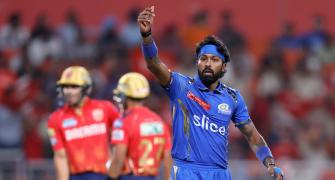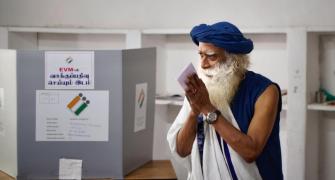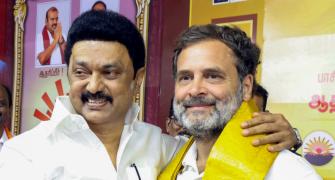The third and final Test between India and South Africa is tantalisingly poised after the visitors picked two wickets late on Day 4, in Cape Town, on Friday.
Chasing 211 for victory, after India were dismissed for 169 in the second innings, the Proteas were 55 for 2 at stumps, still needing 156 runs with eight wickets in hand on a deteriorating fifth day track.
India squandered the advantage of a 41-run lead in the first innings, after being 90 for 2 at one stage in their second essay. Their last three wickets fell for just four runs.
Dale Steyn claimed four wickets to resurrect South Africa's chances of winning the Test.
Morning session
Even for a team prone to be on the receiving end of high drama, the first ten minutes of the fourth day's play at Newlands was going some.
The fun -- okay, using the word loosely -- began in the second over. Virender Sehwag, sent out at the top of the order to see if he couldn't crack the game open for India, flicked Dale Steyn for a four off his pads; one ball later, he lashed out at a harmless ball going well outside off, got the edge and got de Villiers, all in that order 4/3; 6/1).
At the other end, Makhaya Ntini banged one in short; Wasim Jaffar swayed out of line and looked to have left. The ball, however, hit a crack and took off, following the batsman, pinning him in place and clipping the glove to put de Villiers in business again (2/11; 6/2).
And all of that was merely prelude to the real drama: no one came out to bat. The South African players looked puzzled; Shaun Pollock and Graeme Smith began consulting the umpires about the rules regarding a batsman being timed out; Rahul Dravid looked like he could cry; the cameras panned to the Indian dressing room and found no one there who should be: no Tendulkar, no Ganguly, no Laxman, no coach.
The suspense lasted for all of eight minutes before a plainly puzzled Sourav Ganguly came out through the gate, putting his gloves and make up on along the way. It was a while before clarification came: apparently match referee Ranjan Madugalle ruled that since Sachin Tendulkar had been off the field last evening when South Africa was bowled out, he couldn't bat in his usual position.
To the first ball he received, Ganguly thought of continuing the drama: the first ball he received, predictably short, was guided clinically into the slip cordon; to the batsman's luck, it flew between third slip and gully down to the fence for four.
Both batsmen met for a mid-wicket chat, probably to agree that they had given spectators enough heart attacks; from that point on, play settled down to conventional lines and, along the way, the cliche 'out of evil cometh good' got a fresh lease of life.
The Proteas bowlers were really feeling their breakfast oats at this point and bowling like they were radar controlled. Suddenly confronted with a left-right combination, those clean lines fell apart. In the 8th over, Ganguly first played a neat cover drive for a brace, then off drove Dale Steyn with ease and poise. At the other end, Dravid cut Ntini to the point boundary; two overs later the bowler was flicked to fine leg, then smashed through the covers off the front foot. Equally to the point, both batsmen looked to drop the odd ball dead and take off for quick singles, accentuating the left-right advantage and forcing bowlers into constant changes of line.
The real signal that the early morning tide had truly changed, though, came in the 15th over. Ntini, after much fiddling with his field, ran in and banged one down. Ganguly waited on it, moved into position, and pulled fluently away to the midwicket fence (that the shot also brought up India's 50 was, in context, incidental). As a signal of intent, the shot was hard to beat and though the bowler cracked him on the forearm guard with another lifter in the next ball, Ganguly stayed calm, and played the next delivery off his hips, again through midwicket, for a single. The message was, no, it is not quite as simple as running in and banging it down.
The run rate was above the 3 an over mark; Ntini (1/29 in 8) was clearly done; Steyn was off the field, the aggressive field was diluted, and debutant spinner Paul Harris found himself in action as early as the 16th over. At the other end, Ganguly refused to let Pollock settle, slapping him over the slips cordon for the four that brought up the 50 of the partnership (52 runs in 15.2 overs). Pollock, used to having things his own way, was forced to go round the wicket to the left hander to try and slow things down.
The importance of the slender 41 run lead began manifesting itself as well -- when Dravid at the other end straight drove Harris for a single, India had topped the 100 mark , including the lead, in the first session itself: a healthy platform for the batting side, a worrying statistic for the home team looking to bat last.
The run rate at lunch is 2.97 -- and that includes a slow down as lunch approached; there are 66 overs to go in the day. If the batting side can go on at even this pace through the rest of the day, they are looking to be anywhere between 290-310 (inclusive of the lead) at close of play (obviously, if they do find themselves in a very good position at tea, they will logically look to explode the rate of scoring). That will give them a sizeable bank of runs and 90 overs at South Africa on the final day, with the side batting last knowing the chances of forcing a win are slim to none, and therefore being forced onto the defensive from the get-go. For India, that is the optimum situation; then again, this Test has served up enough twists and turns already; who knows what drama lies ahead in session two?
Lunch time score: India 73/2 in 25 overs; Rahul Dravid 30/68; Sourav Ganguly 35/69.
Post-Lunch session
The 7th over after lunch turned the course of the game on its axis.
Jacques Kallis and Paul Harris had taken the ball after lunch and the intent was clearly to keep things tight and keep the Indians from breaking totally free. Sourav Ganguly, in particular, began to fret, and his impatience produced the wicket when in the 32nd over, he pushed hard at an angling delivery from Kallis, opening the bat face to try and make the third man fence but managing only to pick out Herschelle Gibbs in the gully (46/89; 90/3).
The dismissal was unfortunate on many counts. Firstly, it put paid to the left-right combination that had the South African bowlers upset and leaking runs; the bowlers could settle back into optimum lines without needing to change with every single; most significantly, it killed the run rate dead. The five overs following the dismissal produced just 7 runs; in 10 overs together at the crease, Tendulkar and Dravid managed just 15 runs -- and then played out two successive maidens, to rub it in.
During this phase, the most noticeable facet was that the singles, that Dravid and Ganguly had used so effectively before lunch, dried up with neither the captain nor Sachin looking to push the ball into gaps.
The main problem during this phase was Sachin Tendulkar, who looked remarkably out of sorts. He was hit on the knuckles by Kallis and on the elbow by Harris; he seemed uncomfortable against the rookie spinner's line of over the wicket into the rough outside leg stump; against the quicker bowler he kept playing and missing around off and, most importantly, the confident front foot play was in cold storage, with the batsman reverting to playing everything from the crease.
It looked like India was playing to a plan, but damned if you could figure out what it was: there is no situation in cricket that dictates you do not score runs, surely? The situation this morning was dire, yet Ganguly and Dravid had gotten the team out of it with refreshingly positive play that transferred the pressure back on the opposition. Why that course was reversed by the fourth wicket pair is a mystery.
Looked at another way, as long as the runs kept coming, the Proteas could feel the noose tighten; once the fourth wicket pair went into a shell, the fielding side attained a comfort level, knowing it could now concentrate on winkling wickets out, without worrying about the batsmen putting on the board the sort of score that would be impossible to overhaul in the final innings.
Graeme Smith wasn't complaining; he brought Pollock back on for Kallis, to continue the job of strangulation, while leaving Harris to carry on at the other end. And the captain led the fielding effort, positioning himself at a short midwicket for the fast men and producing a stirring series of diving stops as both Tendulkar and Dravid tried to work runs off their legs.
Much was being made in the commentary box, during this period, of the fact that Harris was consistently bowling outside leg stump. Like, you expected something else? The problem was not with the line, which was predictable, but with the fact that the batsmen did nothing to force the bowler to alter it.
Such negative mindsets have, in the past, seen the team paint itself into an impossibly tight corner, and throw away advantageous positions. History repeated itself: Dravid, suddenly waking to the need for runs, tried to drive Harris against the turn, and merely managed to hit the ball back down the track for a simple return catch (47/134 balls; India 114/4). The most startling statistic: Before lunch, Dravid had scored 30 off 68; after lunch, he managed another 17 runs in 66 deliveries (while Tendulkar managed 9 off 45). The 4th wicket partnership was worth 24 runs in 15.1 overs at a run rate, if you can call it that, of 1.54 -- and nothing about the bowling, the pitch or the conditions can explain that.
Another stat: Ganguly played 16 dot balls off 22 faced from Harris, and got 11 runs; Dravid played 37 dot balls and managed 14 off 46 from the bowler; Tendulkar had an incredible 30 dot balls out of 34 faced, and managed 8 runs including a four. Stats such as those would have done a Shane Warne or a Muthaiah Muralitharan proud; for a rookie spinner, it was a dream introduction to Test cricket against supposedly the best players of spin in the world.
Immediately thereafter, VVS Laxman worked Harris off his hips, came back for a second run at his less than electric pace and after some pause for thought, and was beaten by the throw from deep square leg (1/4; India 115/5).
It could easily have been three wickets on the trot: Shaun Pollock got Dinesh Karthick deliberately padding at one; the only thing that saved the batsman was the doubt he created by taking a big stride out, and being struck well outside the line of leg.
Tendulkar meanwhile had worked himself into a state of near panic, stumbling around on the crease especially against Harris, playing and missing against Pollock and generally playing like a rabbit in the headlights. And sure enough, he fell: rapped on the pads by a ball from Pollock that cut back in sharply. The batsman was a touch unlucky, perhaps, in that the ball was landing on middle and leg line and doing enough off the seam to suggest it would miss leg stump -- but for once, given the manner of his batting, it was hard to feel the sympathy you normally do when a batsman is done in by the umpiring (14/62; India 121/6).
The wicket also signalled the tea break. In one mindless session, India had managed to lose 4 wickets while adding just 31 runs in 26.3 overs.
Tennis is, they say, about playing the big points better; cricket, about playing the big sessions well. By that yardstick, India -- with a perfect platform in place at the start of the second session -- mucked up horribly, even inexplicably, and could end up paying a heavy price for it.
Post-Tea session
There was a curious moment early in the session. Harsha Bhogle, in the commentary box at the time, said 'I'd like to see how this young man playing his first Test reacts under this pressure'.
The irony could not have been lost on anyone watching: The six recognised Indian batsmen were back in the hut, for a sum total of 121 runs. And the man putting pressure on the rookie left arm spinner, for the first time in the day, was reserve wicket-keeper Dinesh Karthick.
Harris' line was the same -- over the wicket, a foot outside leg and turning in, with short square leg for the glove or bat pad, a shortish fine leg for the top-edged sweep. No matter -- Karthick swept the bowler for a brace, controlling the shot well. Then swept again, and runs were only saved by a desperate diving stop. The inexperienced Harris felt the pressure and changed his line to leg and middle, as he had in the first innings when Sehwag went after him, and like Sehwag did then, Karthick promptly rocked back, let the ball turn past him, and blasted it through point for four. To rub it in, he went down on one knee in the next over, and reverse swept through point for another three.
Finally, one Indian batsman was playing rookie left arm spin the way it was meant to be -- with invention, with swift feet and twinkling bat and above all, without fear. And it showed immediate results: Smith was happy as long as Harris was keeping the runs down; the minute Karthick signalled aggressive intent, he was forced to take the rookie off and bring Kallis back in an effort to stem the tide.
Tendulkar and Dravid, by repute two of the best batsmen in contemporary cricket, had in a relatively no-pressure situation against the same pair of bowlers, managed 24 runs in 15.1 overs. Dinesh Karthick, who is in this Test as a replacement, and Anil Kumble, who has had an eminently forgettable series with the bat, got together with India 121/6 and almost counted out, and knocked up 26 runs in just 8.1 overs.
To rub the point home, Shaun Pollock's second spell, at the fall of Tendulkar's wicket, read 7-5-2-1. Karthick turned his attention to him, flicking him off his hips to fine leg for four and, an over later, rocking back to take one from outside off and find the point boundary.
Smith figured the time had come for raw pace, and brought Dale Steyn back into the attack for Pollock. The ploy worked. Karthick cut a lifting delivery away and sneaked a three with the sort of running we haven't seen from the Indians in a long while; a ball later, a steepling lifter saw Kumble square up, bat going high in an attempt to play it down. He managed only to get the handle on the ball, which looped up to Gibbs for a comfortable catch (6/22; India 147/7).
The wicket made no difference to Karthick, who greeted Kallis with a ferocious cut that thudded into the boundary despite a sweeper being placed to stop the shot. At the other end, he cover drove Steyn with everything in place -- front foot forward, high left elbow, you name it. And off the last ball of the over, stepped away, and cheekily guided a yorker past gully for a single to retain strike -- so he could, at the other end, blast Kallis through wide long on; waited two deliveries, then pushed back down the pitch and pinched a single under the bowler's nose to make sure Zaheer had only one ball to face.
Boys have stood on burning decks in fable and film; this boy was doing it with style and panache, and suddenly Smith couldn't wave his fielders far enough away.
The 8th wicket pair had added 17 runs in 3.2 overs at a startling 5.1 rpo and, in the process, stretched the lead above the 200 mark, when a moment of madness sent back Zaheer Khan. Karthick drove fluidly through extra cover, raced the single, saw de Villiers hareing after the ball and stopped, holding up his hand and saying no. Zaheer, at the other end, turned blind, paying heed neither to what his partner was doing, nor to where the ball had gone; by the time he realized his error and tried to scramble back, the flat, hard throw had given Boucher the simplest of housekeeping tasks (1/7; 165/8).
Sreesanth managed to guide one through the point-gully region to the fence for four; a ball later, Steyn bowled one through the corridor at express pace, the ball was too close to the stumps for a batsman at number 10; Sreesanth played at it and Kallis, at second slip, went low to hold the hard chance with deceptive ease (4/5; India 169/8).
An innings that began in high drama, segued into farce and went on to stir the pulse, ended in a mini-tragedy. Sreesanth's wicket had fallen off the last ball of Steyn's over but the umpire, presumably caught up in the whole drama, forgot to count. He asked the third umpire, who asked the official scorer, who gave Steyn an extra ball.
Steyn bowled his seventh ball, Munaf Patel backed away and hit it straight to Pollock at mid off, and Dinesh Karthick was left stranded on 38/48, the attacking antithesis to his dour, anything-for-the-team first innings effort.
India was bowled out for 169 in, how do you say this, 64 overs? 64.1 overs? No matter -- South Africa had 211 runs to make, and 113 overs to do it in. By any yardstick, India had scored 75-100 runs below par and, barring early heroics from the Indian bowlers, it was at this point South Africa's game to lose.
Graeme Smith opted to let AB de Villiers face the first over from Zaheer Khan, an interesting ploy that kept him away from the left arm seamer, and allowed him time at the other end to gather himself. From the outset, there was a plan to the way the openers approached the innings -- without ever opening their shoulders, they looked to work the ball around and keep runs ticking; all the time they waited patiently for the bowlers to err, and took toll when they did.
26 runs in eight overs, and India threw its only real card into the game: Anil Kumble, albeit with a hard, shiny ball. De Villiers moved a touch to leg to make room, and easily smacked the second ball of the over through the covers; a ball later, he made room and cut through point for another four. Clearly, the batsman had figured that with a shiny new ball, Kumble wasn't going to get worrisome turn anyway.
Heads were beginning to droop, when de Villiers gave it away. Zaheer pitched the second ball of the 10th over on good length, moving it off the seam; de Villiers, who till then had played on tight lines and done the bulk of the scoring, pushed at it with bat well away from the body, and edged to Karthick (22/33; SA 36/1).
In the first innings, Smith had played Kumble, coming around the wicket, with great assurance (34 runs off 48 balls, five fours). Here, he started out in strangely shambolic fashion, inner edging a desperate sweep to the fine leg fence, then falling over attempting to repeat the shot, and being somewhat lucky to survive a concerted LBW shout. The fall of de Villiers, and Amla's obvious struggles, appeared to be playing on the nerves of the Proteas skipper; the pace of run-scoring dried up and for the first time in the innings, the Indians got animated.
Amla managed two successive fours in the 16th over, off Zaheer, but you got the feeling it was against the run of play. In the next over, Kumble did for him, in a fashion he mostly reserves for tailenders: the quick flipper fired down fast on full length; the batsman hopped back as if Kumble had hurled a grenade, and was pinned on the back foot in front of middle and leg (10/23; SA 55/2).
Amla walked back and so did everyone else. 7.3 overs remained to be bowled, but time had ticked over and stumps were drawn at the fall of the wicket.
It is tempting to say the match is tantalizingly poised. Realistically, though, with South Africa needing 156 runs in 90 overs with eight wickets in hand, the home team will need to bat very badly, and India will need to bowl brilliantly and field the way they did on day two at Johannesburg, for there to be a result other than a Proteas win.
Tailpiece: Munaf Patel's fielding in this game has come in for its share of caustic comment, but none of the words spoken or written highlighted it so much as one little incident today.
Zaheer Khan got Hashim Amla playing the Chinese cut, from outside off to fine leg; Dinesh Karthick whirled around, whipped off his gloves and pads and all, raced after the ball -- and he had run it down, slid, fielded, and thrown back before Patel, then fielding at fine leg, had even come into the camera's frame. That Karthick thought to run after the ball despite there being a fine leg in place tells you what his mates think of Munaf in the field, really. What comment could top that action?








